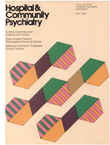Clinical Considerations in Seclusion Room Design
Abstract
Although some uses of seclusion rooms in an inpatient unit put negligible stress on the room, designing a seclusion room requires identifying the maximum stresses it will endure and building it to endure them over a long period of time. Factors to take into account include patients' potential physical strength, the motivational strengths shown in such states as catatonic excitement, the use of "tools" such as concealed coins, and the need to avoid points of purchase that can be gripped or pulled. Clinically based guidelines are given for materials and design of various elements of a seclusion room, such as walls, ceilings, lighting, and heating and cooling.
Access content
To read the fulltext, please use one of the options below to sign in or purchase access.- Personal login
- Institutional Login
- Sign in via OpenAthens
- Register for access
-
Please login/register if you wish to pair your device and check access availability.
Not a subscriber?
PsychiatryOnline subscription options offer access to the DSM-5 library, books, journals, CME, and patient resources. This all-in-one virtual library provides psychiatrists and mental health professionals with key resources for diagnosis, treatment, research, and professional development.
Need more help? PsychiatryOnline Customer Service may be reached by emailing [email protected] or by calling 800-368-5777 (in the U.S.) or 703-907-7322 (outside the U.S.).



